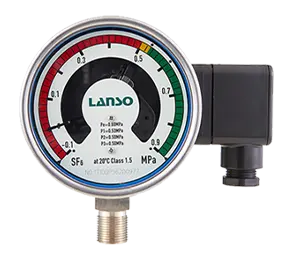SF6 Relay Zero Position Problem in Non-Operating State?
When the density relay is installed and operating in equipment filled with SF6 gas, it is in an isochoric operating state. At this time, the density relay measures the pressure of the SF6 gas in the equipment chamber, which varies with the gas temperature. The pressure increases as the gas temperature rises and decreases as the gas temperature decreases. At the same time, the temperature compensation element compensates for the temperature changes, causing the indication value of the instrument to decrease when the ambient temperature rises and increase when the ambient temperature decreases. The compensation amount of the temperature compensation element is equal in magnitude but opposite in direction to the influence of temperature-induced gas pressure changes on the instrument indication value, so that the instrument indication value is only related to the gas density and independent of temperature-induced gas pressure changes. However, when the density relay is in a non-operating state(no gas filling), the measuring system of the density relay senses the atmospheric pressure, which does not change with temperature. At this time, the separate action of the temperature compensation element causes the pointer of the density relay to be below zero when the ambient temperature is higher than the compensation reference temperature(20℃); and the pointer of the density relay to be above zero when the ambient temperature is lower than the compensation reference temperature(20℃). The specific deviation from zero is temperature-dependent.
SF6 Gas Density Relay Principle
On SF6 gas-filled electrical equipment, the SF6 gas density is represented by the pressure compensated for temperature, namely the pressure value at 20℃. The relay works under rated pressure. When the ambient temperature changes, the pressure of SF6 gas also changes. The measurement system inside the relay compensates for the changed pressure by the temperature compensation unit, keeping the indication value of the rated pressure constant. When SF6 gas leaks for some reason and the pressure after temperature compensation drops to the alarm pressure value, the relay outputs a pair of contacts(alarm signal). At this time, the user is required to replenish the equipment with gas. If the pressure continues to drop and reaches the trip pressure value, the relay outputs another pair of contacts(trip signal), which causes the corresponding control system of the equipment to be locked, thus ensuring the safe operation of the electrical equipment. When the equipment is filled with SF6 gas, if it exceeds the rated value, some density relays can also emit overpressure alarm signals.







